VF-14 Tophatters
enjoy success in Operation Allied Force
"The Tomcat
has truly come of age. After 27 years of service to the fleet, this has been the
aircraft's and the aircrew's greatest contribution."
- Cmdr. Ted Carter,
VF-14 Commanding Officer
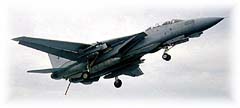 by Lt. Jim Stanley by Lt. Jim Stanley
VF-14 PAO
Months of pre-cruise preparation and training
finally paid off for the VF-14 Tophatters, who led the first Navy
air strike in Operation Allied Force. During the first week of
strikes over the Former Yugoslav Republic, Navy forces met with significant opposition,
including numerous surface-to-air missile launches and anti-aircraft artillery (AAA) fire,
but successfully countered the threat and executed each strike.
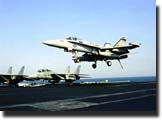 In the weeks that followed, the battlefield picture changed and the NATO
campaign moved to another level. Tophatter Forward Air Controller, Airborne (FAC(A)) aircrews took on the assigned task of striking Serbian military
ground forces deployed throughout Kosovo. The experienced guidance of strike leaders,
solid planning and respect for the capabilities of the Former Republic of Yugoslavia's
ground forces resulted in zero damage to Navy aircraft and the smooth control of Navy and
Air Force aircraft over the hostile skies of Kosovo. In the weeks that followed, the battlefield picture changed and the NATO
campaign moved to another level. Tophatter Forward Air Controller, Airborne (FAC(A)) aircrews took on the assigned task of striking Serbian military
ground forces deployed throughout Kosovo. The experienced guidance of strike leaders,
solid planning and respect for the capabilities of the Former Republic of Yugoslavia's
ground forces resulted in zero damage to Navy aircraft and the smooth control of Navy and
Air Force aircraft over the hostile skies of Kosovo.
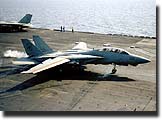 Knowing that NATO had ordered bombing to begin on Serbian Forces in Kosovo
in late March, no one was surprised when, just a week after leaving Norfolk, the
Tophatters, with Carrier Air
Wing Eight, were stationed off the Coast of Italy with live ordnance loaded onto their
F-14A Tomcats. Knowing that NATO had ordered bombing to begin on Serbian Forces in Kosovo
in late March, no one was surprised when, just a week after leaving Norfolk, the
Tophatters, with Carrier Air
Wing Eight, were stationed off the Coast of Italy with live ordnance loaded onto their
F-14A Tomcats.
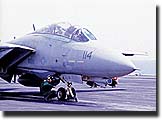  The
first Navy strike led by VF-14 aircrew took place at night. Despite the heavy concentration of AAA and numerous
surface-to-air missiles launched from all around, the Tophatter
aircrew, along with Tomcats from VF-41 and F/A-18s from CVW-8, fought their way into
the target area and delivered their weapons with deadly
accuracy. All airplanes made it safely out of the target area and returned to the waiting carrier late that evening. The
first Navy strike led by VF-14 aircrew took place at night. Despite the heavy concentration of AAA and numerous
surface-to-air missiles launched from all around, the Tophatter
aircrew, along with Tomcats from VF-41 and F/A-18s from CVW-8, fought their way into
the target area and delivered their weapons with deadly
accuracy. All airplanes made it safely out of the target area and returned to the waiting carrier late that evening.
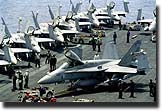 This was followed by a second strike that same night. The aircrews who
were on that first strike did not sleep until they heard from their fellow squadron mates
that the second strike was also a success. Tophatter aircrew
stayed busy from early morning until late in the evening planning subsequent strikes
against fixed targets of the Former Republic of Yugoslavia's command and control
structure. This was followed by a second strike that same night. The aircrews who
were on that first strike did not sleep until they heard from their fellow squadron mates
that the second strike was also a success. Tophatter aircrew
stayed busy from early morning until late in the evening planning subsequent strikes
against fixed targets of the Former Republic of Yugoslavia's command and control
structure.
The success of those strikes was a result of careful planning by
all the Navy strike leaders. They used up-to-date intelligence reports in order to plan an
efficient strike of their assigned targets, while at the same time minimizing the danger
to Navy aircrew.
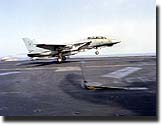 The Tomcat Low Altitude Navigation and Targeting, Infrared at Night (LANTIRN) pod was the critical asset most called upon for those
missions. Capable of identifying targets from considerable distances, the LANTIRN pod was used to find targets in daytime and at
night and guide laser guided bombs to impact with
incredible accuracy. The Tomcat Low Altitude Navigation and Targeting, Infrared at Night (LANTIRN) pod was the critical asset most called upon for those
missions. Capable of identifying targets from considerable distances, the LANTIRN pod was used to find targets in daytime and at
night and guide laser guided bombs to impact with
incredible accuracy.
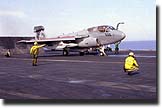 As Navy strikes continued, the need to locate and target Serbian military
forces became apparent. FAC(A) aircrews from VF-14 and VF-41 were sent over Kosovo to do the job, under the protective
watch of the EA-6B Prowler jets from VAQ-141. As Navy strikes continued, the need to locate and target Serbian military
forces became apparent. FAC(A) aircrews from VF-14 and VF-41 were sent over Kosovo to do the job, under the protective
watch of the EA-6B Prowler jets from VAQ-141.
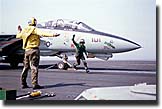 Tophatter F-14s routinely managed
the battlespace while they located hostile ground targets. Once they found a target, they
called upon sections of F-14 Tomcats or F/A-18
Hornets from the air wing, or Air Force aircraft such as A-10 Thunderbolts and F-16
Falcons, to deliver their weapons. Tophatter F-14s routinely managed
the battlespace while they located hostile ground targets. Once they found a target, they
called upon sections of F-14 Tomcats or F/A-18
Hornets from the air wing, or Air Force aircraft such as A-10 Thunderbolts and F-16
Falcons, to deliver their weapons.
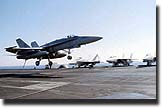 The ability of the Tomcat FAC(A) aircrews to
pass targeting information to other aircraft quickly, and to flow those aircraft into a
target area efficiently was the result of many hours of pre-flight planning and airborne
flexibility. The value of a Tomcat FAC(A) quickly became
evident against the rapidly advancing Serbian forces in Kosovo. The ability of the Tomcat FAC(A) aircrews to
pass targeting information to other aircraft quickly, and to flow those aircraft into a
target area efficiently was the result of many hours of pre-flight planning and airborne
flexibility. The value of a Tomcat FAC(A) quickly became
evident against the rapidly advancing Serbian forces in Kosovo.
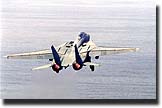 "The Tomcat has truly come of age," said VF-14 Commanding Officer Cmdr. Ted Carter. "After 27 years
of service to the fleet, this has been the aircraft's and the aircrew's greatest
contribution. Our success in Operation Allied Force was a total
team effort that has proven the value of a two-seat cockpit." "The Tomcat has truly come of age," said VF-14 Commanding Officer Cmdr. Ted Carter. "After 27 years
of service to the fleet, this has been the aircraft's and the aircrew's greatest
contribution. Our success in Operation Allied Force was a total
team effort that has proven the value of a two-seat cockpit."
Tophatter F-14 Tomcats expended
over 395,000 pounds of ordnance on various targets in support of Operation
Allied Force. Carter added, "Our tireless ordnancemen
loaded over 800,000 pounds of ordnance in two months in VF-14 alone. Combined with an
outstanding maintenance effort, the work of our troops was
most impressive."
Tophatter aircrews led the air wing in
strike missions as airborne forward air controllers. By using the capabilities of their
state-of-the-art LANTIRN pod to the fullest in this conflict,
the Tophatters of VF-14 helped to prove that the F-14 Tomcat is one of the most accurate and lethal aircraft in the
air-to-ground arena. |